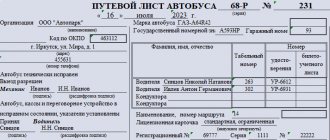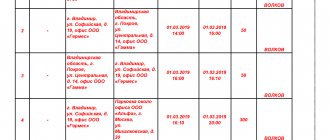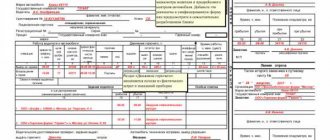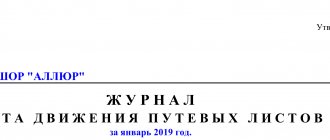Waybills for enterprises and organizations
Organizations that provide drivers with work cars are required to fill out waybills. They are necessary to correctly calculate the driver’s salary, monitor the use of transport, and keep track of spent budget funds.
Also, the waybill is one of the main documents confirming the organization’s fuel costs. If the waybill does not contain information about the route, then the tax office may have a question about the justification of the costs of fuel and lubricants.
Who deals with waybills at the enterprise
Since waybills are an important document for accounting for funds in the transport department, the personnel officer, accountant, head of the transport department, taxi operator and other responsible persons who in one way or another interact with the transport department have access to waybills.
Who fills out the waybill in the organization
Different people can fill out waybills at an enterprise. In transport organizations this is done by dispatchers. In other companies, this responsibility is assigned to an accountant or manager, or taxi operator. In general, any employee in the company can fill out waybills if it is specified in the work instructions.
In order to appoint an employee responsible for waybills, it is necessary to issue an order. The document must contain the following information:
- Name of the organization;
- Information about the employee and basic information about his position;
- Date of return to work;
- A reference to the regulations that guide the specialist - schedule, job description, regulations on the work of the department.
An example of an order appointing someone responsible for waybills
Who issues waybills to drivers in organizations
After the dispatcher or other responsible person enters information about the driver, vehicle, organization, etc., the waybill is printed and given to the driver. In some organizations, the waybill is filled out by a special terminal. The driver’s task is to go to the terminal and enter his identification number.
Such terminals are usually located at the entrance to work.
Who can sign waybills in the organization
There must be a total of three signatures on the waybill. First of all, the employee who fills it out signs. As mentioned above, this can be any employee whose job description includes such a responsibility.
The second required signature on the sheet is the mechanic’s signature. Before the driver goes on the line, he must undergo a technical check of the car. If the vehicle is in good working order, the mechanic confirms its readiness for operation with his signature on the waybill.
The third signature is the physician’s signature. The company may hire a full-time doctor or enter into an agreement with a medical institution with a license to conduct medical examinations.
The signature of the driver who used the car is not required
When and for what period is a waybill filled out?
The document is issued either for one day or for one flight before departure (Order No. 368, paragraph 9).
If the duration of the flight exceeds the length of the shift or working day, the waybill will be valid for the entire flight.
If there are several flights during the day or change, you need to issue a waybill before the first flight. This waybill will be valid for one day.
If during the trip several drivers will drive the car in turn, then before the trip the waybill must be issued for each driver separately.
Typically, the form is completed by a dispatcher or other authorized employee. This obligation must be established by order of the manager, since the employee is responsible for errors made during registration.
Automatic control of organization fines
Who checks the organization’s waybills?
Many government organizations can check waybills. Employees of the Federal Tax Service use them to identify errors when accounting for fuel and lubricants and reducing income tax. The labor inspectorate checks compliance with the rights of an enterprise employee, for example, to rest. Waybills also help traffic police officers understand how legally the driver is driving the car. Tax inspectors also have the opportunity to view waybills when conducting on-site or desk audits.
If representatives of other services request waybills, the organization has the right to refuse
Electronic accounting of waybills at the enterprise
Organizations are required not only to create waybills for each employee’s trip, but also to store them for several years. It is also necessary to keep records of all forms issued. To do this, use a special journal of form No. 8.
Let's see how organizations without special programs work with waybills. The driver comes to work and goes to the dispatcher, who manually enters data into the waybill, simultaneously filling out the log book. Then the driver goes to the mechanic and the doctor, both sign their names. Only after this can the shift begin. During the day, the driver enters trip data into the waybill, and at the end of the shift records the odometer readings. Then the waybill again goes to the dispatcher. He checks the indicators, enters travel data and passes the travel sheet to the accountant, who transfers the information into the accounting program.
The chain is quite long and inconvenient. As a result, dispatchers have to work with several programs at once, drivers are unable to get to work for a long time, and organizations suffer from low efficiency of work processes.
Program for waybills: what it can do and how it works
To simplify the process of working with waybills, organizations purchase special programs. And although this saves time, many processes remain unautomated. For example, the dispatcher processes information on the route, and the mechanic draws up a driver schedule. If the driver changes, the mechanic redoes the schedule in the program and resends it to the dispatcher. Meanwhile, the waybill is filled out in another program. In a hurry, the data of the other driver and the car is entered, a new waybill is updated and printed. The dispatcher checks the information, and if he finds an error, the mechanic repeats everything again.
How “TM: Corporate Travel” works with waybills
All processes are synchronized.
The “TM: Corporate Travel” program allows you to plan a driver’s work schedule, fill out a waybill, collect data on applications and trips in one place, and then transfer the pool of necessary information to accounting systems.
The system contains approved forms of waybills for all types of transport: trucks and cars, buses and special equipment. “TM: Corporate Travel” generates a waybill at the touch of a button as soon as the driver appears in the system, that is, starts a shift in the driver’s application. Thus, there is no need to enter data manually or transfer it between departments. There will be no more errors when filling out.
Ready printed form
To receive a ready-made sheet, the driver:
- Passes a medical examination with a mark: a seal or an electronic digital signature.
- Gives the mechanic's full name or presents a permit with a medical examination stamp in paper form.
- He waits a few seconds until the mechanic sends the waybill to print with the press of one key. The document is automatically generated by the program.
- Receives a waybill and begins to fulfill the application.
- The system is the same for all employees. Therefore, the dispatcher immediately sees the work schedule created by the mechanic.
Indefinite data storage.
Another advantage of the “TM: Corporate Travel” software package is that it indefinitely stores the data necessary for travel sheets. Even if the accounting system fails, the data can be restored.
For example, the data of the car in which the driver went on a trip was required. To do this, you need to detail the driver’s trips for the required period and get information from the saved sheet. For example, Pilot LLC allows Ivan Ivanov to drive an Opel car with state license plate H111ET on January 1, 2022 and work from 9 a.m. to 5 p.m. on all requests within the city of Moscow.
All information that arises during the operation of the fleet is recorded in the database. You can also restore:
- route on the map: planned and actual;
- the beginning and end of the route;
- the number of orders;
- planned and actual work time;
- correspondence with the dispatcher;
- which buttons were pressed by the driver and which by the dispatcher;
- telephone conversations;
- car mileage.
Integrates with other programs.
TM: Corporate Travel has an open API that allows you to configure data exchange between two different software systems. We integrate the software package so that all information on the vehicle fleet is collected in one place. The user does not have to work in different programs and manually transfer data between them.
You can configure integration with programs:
- “1C:Enterprise” - thanks to integration, this program will receive data on applications, the actual work schedule of drivers, mileage, etc.;
- AutoGRAPH or Wialon - integration will allow you to control the movement of drivers, calculate optimal travel routes, and make more informed transport and logistics decisions.
- GLONASS or GPS - interaction with satellite systems makes it possible to see deviations from the route and quickly respond to them.
Electronic waybill logbook
To track the movement of waybills, there is a log book. Previously, it could only be filled out using Form No. 8, but since January 2013 the rules have become softer. Now companies have the right to develop their own form of accounting log, provided that it reflects the following data: waybill number, date of issue, driver’s full name, personnel number, garage number of the car, signature of the dispatcher, accountant. It is also not prohibited to keep a journal in electronic form, but only if it can be printed at any time.
An example of how data from “TM: Corporate Travel” ends up in the 1C system accounting log
Changes in legislation on transportation documents
New rules for document flow are introduced by Federal Law No. 336-FZ of July 2, 2021 “On Amendments to Article 31 of the Federal Law “On Highways and Road Activities in the Russian Federation”” and the Federal Law “Charter of Automobile Transport and Urban Ground Electric Transport.”
The law defines the concept of an information system for electronic transportation documents. This system will ensure the exchange of electronic transportation documents and information contained in them between participants in information interaction.
The law specifies what types of electronic transportation documents will be used in the system: electronic waybill, electronic work order and electronic accompanying statement.
Requirements for information systems of electronic document management operators, as well as formats and procedures for transmitting electronic transportation documents, should be developed by the Ministry of Transport and the Federal Tax Service by the end of this year.
Regulations for issuing waybills at the enterprise
Although the form for filling out the waybill has become more free, it contains mandatory information, without which the waybill will be considered invalid.
Data required on the waybill in 2022
The procedure for issuing a waybill in an organization
Each company has its own procedure for issuing waybills, depending on internal work standards. Basically, it all starts with the dispatcher filling out the document, after which the doctor and mechanic are marked, then the driver goes on shift, and at the end of the day he takes the readings from the odometer, FLS, enters them into the waybill and puts his signature. The signatures of the mechanic and the doctor are again affixed, then the waybill is handed over to the dispatcher.
Do you need a seal (stamp) of the organization on the waybill in 2021?
The seal or stamp of the organization is not a mandatory element in the waybill. The basic details of the organization are enough. There are also no orders that would oblige a doctor or mechanic to put their stamp on the waybill.
Opened form:
A waybill for a passenger car is mandatory for use in the process of organizing transportation, when planning, managing and accounting for the transportation of goods or passengers by road and is drawn up in accordance with the “Instructions on the procedure for payments for transportation by road” (November 30, 1983, as amended and supplemented by the State Statistics Committee Russia dated November 28, 1997). In accordance with the Resolution of the State Statistics Committee of Russia dated November 28, 1997 No. 78, the primary documents for recording work in freight and passenger road transport include: waybill for a passenger car (form No. 3), waybill for a truck (form No. 4-c or No. 4-p), Journal of the movement of waybills (form No. 8) and Consignment note (form No. 1-T).
When working on passenger vehicles, a full-time driver must have the following documents:
- a driver's license of the appropriate category or temporary permit;
- registration documents for the vehicle and trailer, if used;
- waybill according to form No. 3;
- consignment note (form No. 1-T) for the transported cargo;
- when transporting large, heavy and dangerous goods - a special permit.
Responsibility for correctly filling out the waybill lies with the heads of enterprises, organizations, institutions, as well as persons responsible for the operation of passenger cars and participating in filling out the document. The driver's participation in filling out the waybill form is not allowed, with the exception of signatures certifying the acceptance (upon departure) and delivery (upon return) of the car.
Before issuing a waybill to the driver, the dispatcher or an authorized person fills out Form No. 3, indicating: the date of its issue (day, month, year), which must correspond to the date of registration in the waybill log; in the line “Operating mode” writes down the code or name of the operating mode (weekdays, business trips, summarized recording of working hours, daily recording of working hours, work on a weekend or holiday, work on schedule or outside of schedule, etc.), in accordance with whom the driver’s wages are calculated; in the “Car” line indicates the make, license plate number and type of the car, as well as its garage number. In the case of using trailers or semi-trailers, their brands, garage and license plate numbers are recorded in the “Trailers” line. The line “Accompanying person” must contain the surnames and initials of the persons accompanying the vehicle as part of the task. In the “Work of the driver and the vehicle” section, column 2 records the time (hours and minutes) of departure and return of the vehicle according to the schedule. In column 15 “At whose disposal” of the “Assignment to the driver” section, based on an application or a one-time order, the name of the customer is recorded. Column 16 “Arrival time” must reflect the time (in hours and minutes) of the vehicle’s arrival at the customer’s location in accordance with his application, a one-time order, or the vehicle’s work schedule under the terms of the contract. On the front side, the waybill form contains the line “Issue fuel” - in it you must indicate in words the amount of fuel required to be issued to complete the task, taking into account the remaining fuel from the previous day of work. The correct execution of the waybill and the presence of the driver’s driver’s license is certified by the dispatcher or an authorized person with his signature in the line “Signature of the dispatcher.”
Next, before leaving the garage, the tanker (fuel and lubricants technician, authorized person) in the section “Fuel Movement” in columns 6, 8 and in the corresponding lines records the amount of fuel issued, as well as the series and numbers of issued fuel coupons and certifies these entries with his signature. On the front side, the unified form No. 3 requires the mark of a medical worker who, during a pre-trip medical examination, certifies with a signature the driver’s health status and the possibility of his being allowed to drive a car. In the section of the waybill “Work of the driver and the vehicle” in column 4 “Speedometer readings” the mechanic of the checkpoint (checkpoint) or the technical control department (TCD) records the speedometer reading when the car enters the line, and in column 5 “Actual time” enters actual time the car left the garage (day, month, hours, minutes); in the “Movement of Fuel” section in column 9 “Remaining upon departure”, he enters the amount of fuel in the vehicle’s tanks upon departure, and certifies the correctness of all entries made by signing in this column. In the line “Signature of the mechanic”, the transmission or quality control mechanic must certify with his signature the transfer of the car to the driver in technically sound condition and permission to leave the garage, and in the line “Signature of the driver” - the driver must sign for acceptance of the car in technically sound condition and receipt of the task for work.
Filling out the waybill on the line is carried out in the following sequence: in column 19 “Arrival time”, enter the time (hours and minutes) when the driver presents the waybill to the customer; in the “Customer” column, the customer signs and puts a stamp, confirming the correctness of the details of the waybill filled out by him; in columns 21 “On arrival” and 22 “On departure”, the customer enters the speedometer readings upon arrival and departure, respectively. In the lines “Special work of the driver and the car” in column 2, the transmission mechanic or quality control department writes down the actual time the car returned to the garage (day, month, hours, minutes) and fills out column 4 “Speedometer readings”; fills out column 10 “Balance upon return” in the “Movement of Fuel” section and signs under it. In the “Movement of Fuel” section, the tanker, fuel and lubricants technician or authorized person, when the driver submits coupons for fuel and lubricants, fills out column 11 “Passed” and signs under it. In the “Passed Over” line, the driver confirms with his signature that the vehicle has been handed over to the transmission or quality control mechanic in a technically sound (faulty) condition. The gearbox or quality control mechanic in the line “Accepted” with his signature certifies that columns 5 and 6 of the line “Return to the garage” of the section “Operation of the driver and the car” are filled out correctly and the car is accepted from the driver in a technically sound (faulty) condition. After the driver submits the waybill, the dispatcher or other authorized person signs in the line “Accepted by the dispatcher” and registers the waybill in the appropriate journal (Form No. 8).
The form of waybill is issued to the driver by the dispatcher against receipt for one working day, subject to the delivery of the waybill for the previous day of work. An intercity waybill is also issued for a longer period, if the duration of transportation must be more than a day. There is also the possibility of an organization using its own waybills, which have a monthly validity period and are approved in the accounting policy of the given enterprise. According to Letter of the Ministry of Finance of Russia dated November 15, 2005 No. 03-03-04/1/363, they are allowed for a passenger car driven by an employee by proxy and not transporting goods or passengers, and are intended to confirm fuel costs for profit tax purposes.
For individual entrepreneurs, by order of the Ministry of Transport of Russia dated June 30, 2000 N 68 “On the introduction of travel documentation for individual entrepreneurs carrying out transportation activities in road transport,” their mandatory forms of waybills were approved: PG-1 for a truck; PA-1 for bus; PL-1 for a passenger car. However, an individual entrepreneur will be able to use them to account for transport expenses for business activities only if “the certificate of state registration of the entrepreneur will indicate both types of activities: trade and procurement and cargo transportation” (letter from the Federal Tax Service of Russia for Moscow dated December 31. 2004 N 21-14/85240).
See also:
Apply for a waybill Sample of a waybill - pdf Sample of a waybill - gif
Questions and answers on the form
Storage period for waybills in the organization
The minimum storage period for waybills is established by order of the Federal Archive of December 20, 2019 No. 236 and is 5 years. The period may be extended if the State Tax Inspectorate has not been checked during this time. Please note that documents can only be stored in the archive starting from the next calendar year. Imagine that you have created two waybills: one on January 1, 2022, the second on December 31, 2020, both documents will be deposited on January 1, 2022.
If in an organization the waybill is the only document that confirms dangerous working conditions, then the shelf life increases from 50 to 75 years.
How long are waybills stored in an organization and what is the procedure for their destruction?
As already mentioned, waybills must be stored for at least five years, but only if a GIT check or audit has taken place. Since the laws are quite ambiguous, we advise storing documents for at least 7 years, and only after that setting up a procedure for destroying documents. To destroy old waybills, it is necessary to assemble a commission and draw up an act. There are two ways to destroy waybills: burn them or cut them into small pieces with a shredder.
Waybill form
If an organization decides to use a waybill as a primary accounting document, it can take one of the forms approved by Decree of the State Statistics Committee of the Russian Federation dated November 28, 1997 N 78. The most common among non-specialized organizations:
- Form of waybill for passenger transport; Excel
- Waybill form for freight transport. Excel
But, even if it changes the unified form, it is necessary that the form contains all the mandatory details of the waybill approved by Order of the Ministry of Transport of the Russian Federation dated September 18, 2008 N 152 (hereinafter referred to as Order of the Ministry of Transport of the Russian Federation N 152):
- name and number of waybill;
- information about the validity period of the waybill - until what date is it valid;
- information about the owner (possessor) of the vehicle (vehicle): organization - name, legal form, location, telephone number, OGRN;
- Individual entrepreneur - last name, first name, patronymic, postal address, telephone number, OGRN.
- vehicle type - passenger car, truck, bus, etc. (clause 3 of PTS);
- departure;
- last name, first name, patronymic of the driver;
Fine without waybill for organization
If the driver does not have a waybill, the organization may receive a fine. The traffic police inspector has the right to issue a fine of 500 rubles. and send the car to a fine parking lot. Larger fines may be imposed if there is no mark on passing a medical examination for the driver - 3,000 rubles, for the manager - 5,000 rubles. An organization can be fined 30,000 rubles or more if medical examinations are not carried out at all. Thus, in 2022, in Saratov, the court upheld a fine of 115,000 imposed by the Labor Inspectorate for the lack of a pre-trip inspection.
Changes in travel documents from 2021
On January 1, 2022, Order No. 368 of the Ministry of Transport came into force, as a result of which several mandatory items were added:
- Transportation information - you must indicate what is being transported: cargo, passengers and luggage, children.
- Vehicle information - now you need to indicate the make of the car.
- The procedure for marking a medical examination and technical control.
- Possibility to keep a journal in electronic form.
The procedure for issuing a waybill in 2022
Electronic waybill - project of the Ministry of Transport
In October 2022, a pilot project for working with electronic waybills was launched in Moscow, Tatarstan, Moscow, Kaluga, Ryazan regions and Krasnodar Territory. Project participants will issue waybills electronically and submit them to the Ministry of Transport through the Superservice 22 system.
How electronic waybills look in the Superservice 22 program
Immediate prospects
The experiment to switch to electronic waybills and waybills is only part of the large-scale project “Paperless transportation of passengers and cargo.”
The result of this project should be the complete elimination of paper documents. Drivers on the line will present traffic police inspectors with an abstract set of symbols on their phone, and inspectors will use their smartphone to go online and find the required document using the code.
In addition, as part of the project, the carrier’s personal account should appear on the government services website. It will organize a workspace for processing EPL and other documents, including permits for the transportation of large and dangerous goods, reserving time for crossing the state border, etc.
The Superservice 22 system will operate in pilot mode until 2021. It is expected that by 2024 it will be finalized and implemented in all regions of the country.
Paperless transportation of passengers and cargo will simplify the preparation and storage of waybills, and facilitate the approval of the document by a medical worker and a technical specialist within their areas of responsibility. The state plans to obtain a control tool over carriers, shippers and consignees.








